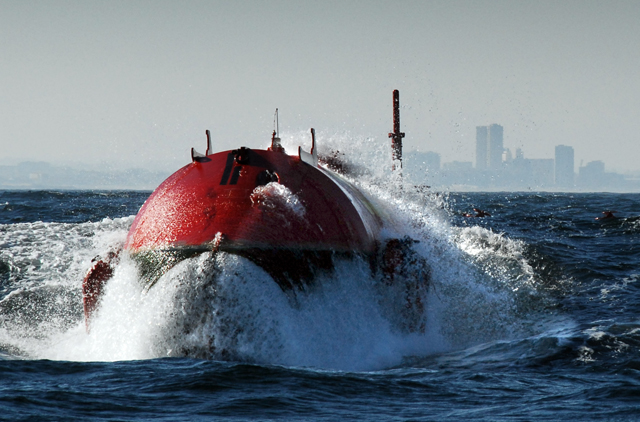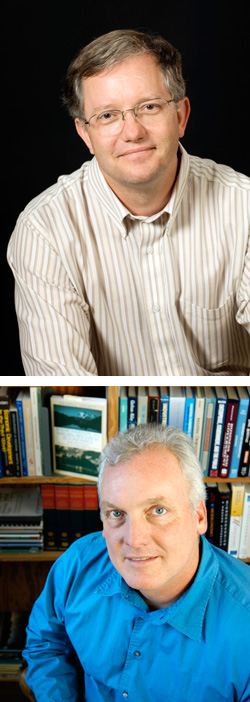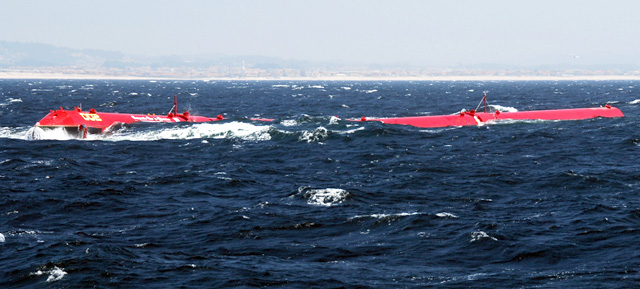
The new findings suggest Humboldt County stands to gain hundreds of megawatts of sustainable electricity from so-called wave energy conversion farms. They would consist of offshore buoys which, through one of several proposed technologies, would capture a part of wave motion and convert it into electrical power.
In addition to the benefits of an alternative energy source and the profitable export of electricity elsewhere, the farm’s construction and operation probably would infuse the Redwood economy with hundreds of well-paid jobs, taking into account direct, indirect and induced employment from an industry cluster.

But HSU contributors Steven Hackett, Professor of Economics, and Greg Crawford, chair of the Department of Oceanography, caution that development and production will require a good deal of time—wave energy conversion is not going to make the North Coast energy independent or generate a lot of jobs in a year or two, or even several. For one thing, much more needs to be known about the efficiency, costs and impacts of wave conversion farms.
The white paper is titled “Developing Wave Energy in Coastal California: Potential Socio-Economic and Environmental Effects.” It was prepared for the California Ocean Protection Council and the Public Interest Energy Research Program of the California Energy Commission.
In an interview, Hackett and Crawford said the paper will help guide state agencies as they apportion research funds and assess proposals for wave energy conversion projects in the next five years or so.
In company with 13 co-authors, the HSU professors agree that far more research and data about existing marine uses should be collected to ensure policymakers and political leaders make informed decisions about the deployment of seaborne, wave-harnessing technologies. They say higher resolution and higher quality spatial information is needed about the extent and locations of commercial and recreation fishing sites, marine transit routes, marine vegetation harvesting, surfing and coastal recreation, wildlife viewing and aesthetic vantage points. The paper recommends compiling the new information in GIS (Geographical Information System) map formats.
Such a comprehensive database would equip policymakers to assess the probable impact of wave conversion accurately and balance competing interests; not only commercial and recreational fishing, but also marine species protection (including migrating whales), shoreline conservation and the shielding of valuable cultural artifacts like shipwrecks. What decision makers need is a system of strategic tradeoffs to guide their choices over the long-term, the HSU dons say.
Looking at all the Issues
A good example, says Hackett, is location. The optimum place for a wave farm is close to shore, close to an electrical substation and near a harbor that can service the farm. Economically and logistically, proximity to the coastline is ideal. But these same locations are crucial to commercial fishing, coastal marine recreation and safe navigation, among others. Wave energy conversion will have to be managed carefully.
In Hackett’s words, “We need to identify the least amount of adverse impact, but still meet the needs of the wave farm developers.”
Accordingly, Crawford added, state leaders should address a full roster of serious issues. For one thing, the conversion equipment would have to be moored in some fashion to the ocean bottom, presumably with an elaborate system of cables. They would present a navigation hazard; they might also pose a risk to migrating whales.
Both the wave conversion farms and their cabling networks could act as an artificial coral reef, inviting fish aggregations. Fisherman would want to exploit these lucrative grounds, but they would be off-limits for safety reasons, to avoid collisions and the entanglement of gear with conversion equipment.
If numerous and large wave conversion farms were contemplated, the impact on commercial fishing grounds would have to be gauged beforehand. Hackett raised the questions to be answered. At what threshold would the shrinkage of grounds render the local fishing industry unviable? What is the minimum scale the industry must have to sustain Humboldt’s port facilities, processors and allied businesses?
Yet another sticking point is the disruption of natural wave propagation and its potential chain-reaction effects on Redwood coastlines. Crawford said ocean waves play a big role in moving sediment and keeping beaches healthy. “When you reduce the waves’ ability to reach the shoreline and crash in a natural way, you may get excess erosion in some places and excess deposition in others,” he said. “The change to the beachfront might be relatively significant, or it might not.”
Hackett and Crawford agree that wave energy conversion is here to stay, but its success hinges on balancing energy independence and conservation with the development of the coastal economy and creating new jobs. In the words of the white paper, “wave energy could meet a significant proportion of the state’s energy demand.” For the time being, ecological issues appear “manageable,” but “significant technological and economic issues remain.”

A Rapidly Advancing Field
International competitive pressure is a crucial factor. Western Europe is well ahead of the United States in wave conversion investment, not only in technological development but also in commercial deployment subsidies. Spain and Portugal are busy at work on initial tests of the Pelamis device, a series of articulated metal cylinders linked by hinged joints. Waves set the joints in motion. The joints are resisted by hydraulic rams that pump high-pressure fluid through hydraulic motors, which in turn drive electrical generators.
The Pelamis test bed comprises three 450-foot+ “snakes” deployed in September 2008 for the world’s first, commercial-scale wave conversion farm just offshore from Agucadoura, Portugal. The converters reportedly generate 2.25 MW of peak power capacity. Plans call for expansion with a further 25 ‘snakes,’ estimated to generate 21 MW of peak power capacity. (Pelamis is the scientific name for a sea snake.)
A second conversion technology utilizes an oscillating water column that relies on a partially submerged chamber. The oscillations force air through a turbine/generator to produce electricity. A test bed has been deployed at Port Kembla, Australia.
“These technologies are well under way, these aren’t just on the drawing board,” Crawford noted. He said PG&E has talked about prototyping a “laboratory” of transmission cables and devices to test the feasibility of wave energy conversion, and evaluate which generating technologies are optimal.
The white paper recommends that state agencies and policy makers evaluate the efficiency and performance of each conversion technology, including third party analysis as well as manufacturer claims.
The report also calls for:
—Detailed monitoring of wave conditions inshore of pilot conversion systems
—Direct observation of impacts on sediment transport, morphology and near-shore water quality, using before-and-after studies
—Simulations of wave behavior around small-scale conversion equipment
—Evaluation of the sound, vibration and electromagnetic field effects of conversion technology on selected species
—Monitoring gray whale migration behavior to determine if there is a minimum installation size that leaves behavior undisturbed
—Direct field studies of species nearly certain to be affected by conversion installations, including among others gulls, cormorants and sea lions.
—Free sharing of data via partnership agreements among the conversion industry, ocean observing system organizations and ecological monitoring programs.